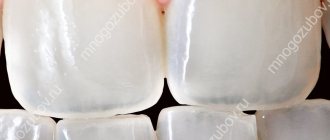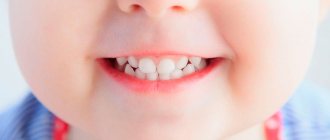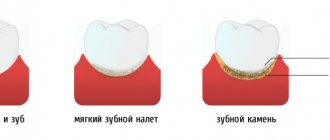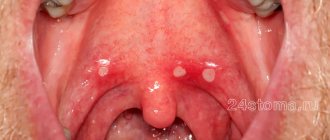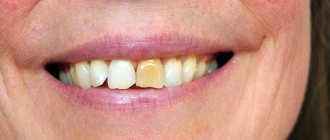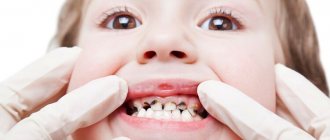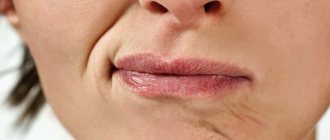By nature, the natural color of human teeth has never been immaculately white. Watching the radiant smiles of stars from television screens, you get the impression that your teeth are not so white and attractive. In addition, the color of the enamel is daily exposed to the negative effects of all kinds of coloring products and bad habits. Why does a child have yellow teeth, and also why is tooth enamel yellow in general and what to do about it? To answer all the questions posed, you first need to understand the main causes of yellowing of the enamel.
Dark or yellow enamel
A beautiful smile is the key to self-confidence and comfortable communication. If teeth become dark or yellow, it significantly reduces self-esteem. Very often, patients, noticing yellowing of the enamel, resort to traditional methods. But, as practice shows, such measures do not produce significant results, but only destroy the protective shell. Therefore, you should visit a dentist so that he can identify the cause of yellowing or darkening of the enamel and can prescribe safe and effective procedures to correct the situation.
Reasons for changing the shade of enamel
Conventionally, the reasons that teeth become yellow or dark can be divided into two main groups: external influences (food dyes, smoking, poor hygiene) and internal influences (health conditions, removal of the dental nerve, etc.). Let's look at them in more detail.
Nutritional Features
Quite often, the enamel turns yellow or darkens due to regular exposure to drinks and products that contain coloring pigments - coffee, tea, seasonings, chocolate, beets, etc. Coloring substances accumulate in the micropores of tooth enamel and dentin, which leads to a change in shade teeth.
Environmental factors
Tooth enamel can change its shade as a result of extremely poor ecology, when a person works in hazardous industries and consumes bad water, in particular, with a high fluoride content (white spots appear). Darker shades can form when the body is exposed to lead, bromine, mercury and other hazardous substances.
Hygiene factors
Poor oral hygiene leads to discoloration of teeth due to plaque formation. It occurs due to irregular, poor-quality cleaning or due to incorrectly selected products. As a result, the enamel becomes darker due to the accumulation of large amounts of deposits.
Age-related changes
Over the years, tooth enamel becomes thinner, through which darker dentin begins to show through. It is for this reason that yellow teeth appear in most people in old age.
Various diseases and their treatment
Another common cause of darkening of the enamel is diseases of the internal organs, as well as their treatment with certain drugs. The use of certain types of antibiotics, for example, tetracycline, leads to the appearance of dark stripes on the enamel (especially if it was taken during the formation of the child’s teeth during intrauterine development or their growth in the first years of life). With fluorosis, white spots may appear on the enamel, which over time become yellow-brown.
On a note! In the absence of the dental nerve (pulp), the tooth darkens over time - this is a completely normal and physiological process. Unfortunately, whitening is usually not effective in this situation, so it is worth considering the installation of veneers or lumineers.
If the tooth becomes red, this indicates damage or inflammation of the dental nerve, which requires surgical treatment by a dentist.
Bad habits
Smoking causes permanent plaque to form on the surface of the teeth, causing them to turn yellow. If you can’t give up the habit, you should strengthen your oral hygiene, as well as regularly carry out comprehensive professional hygiene at the dentist - every 3-5 months to better cleanse your teeth of plaque.
What does it represent?
Yellow plaque is rather a collective name.
In fact, its shade varies from light yellowish to yellow-brown or even grayish. Appears in both children and adults. This does not depend on age, but on other reasons that will be discussed later. In most cases, plaque of such shades is an accumulation of bacteria and microorganisms, including dead ones, as well as their metabolic products.
There are bacteria in the oral cavity . Many of them are beneficial and help in the process of digesting food. However, a sharp increase in their number leads to unpleasant consequences .
First of all, it is a yellow coating. It accumulates on the teeth all the time, but most of it will be removed from the enamel through daily hygiene procedures such as brushing and flossing.
Also, properly selected food products, including fresh vegetables and fruits, help remove deposits throughout the day.
If plaque is not removed in a timely manner, it becomes noticeable and heavily colored. In addition to the aesthetic side, you should also remember about its detrimental effect on the teeth themselves.
Varieties
Yellow deposits have a different character. The most common type is bacterial , when there are a large number of microorganisms in the oral cavity. However, he is far from the only one.
Sometimes teeth become yellowish or yellow-brown due to traumatic factors . Here, in fact, there is no plaque, but outwardly the shade of the enamel is perceived this way.
Stages of formation
The process of deposit formation is divided into three main phases. It is worth noting that this process of formation of dental plaque will be true only for the most common type of yellow plaque - bacterial .
- Soon after cleaning, approximately 2.5–4 hours, various bacteria appear in the oral cavity and begin to actively multiply , including staphylococci, streptococci, lactobacilli and others. At this time their number can reach up to a million.
- The next phase is from 4 to 6–7 hours after using the brush and paste. The number of bacteria increases approximately tenfold, and the teeth themselves become covered with a thin and invisible film , which is already plaque.
- About a week passes until the next phase, when the plaque becomes more dense and is not washed off with regular cleaning .
At the same time, it becomes a breeding ground for pathogenic bacteria, which continue to participate in the process of further formation, and also cause the appearance of bad breath.
Treatment methods
Restoring the aesthetics of enamel should begin with a visit to the attending physician, who can determine the exact cause of the problem. If necessary, you will have to visit other specialized specialists, for example, an endocrinologist or gastroenterologist. The first thing you need to do at the dentist's office is to undergo a comprehensive cleaning, which will get rid of plaque and thereby make your teeth cleaner. If the enamel has darkened significantly, it is recommended to use professional teeth whitening. And if this does not help, you can put protective overlays on the front surface - veneers or lumineers.
The procedure is performed in the dental hygienist's office. It allows you to remove plaque and tartar not only from the surface of the teeth, but also from the subgingival area and other hard-to-reach places. Ultrasonic, manual and air-abrasive cleaning is used. As a result, teeth become noticeably cleaner, and the enamel returns to its natural shade.
The Amazing White brand produces a whole range of different products, the use of which allows you to achieve a snow-white enamel color. The method is based on special gels containing hydrogen peroxide in various concentrations. It is recommended to carry out professional whitening and then maintain the results at home.
The ZOOM system is considered one of the most effective today. It is based on the use of a special active gel, the components of which penetrate deep into the tooth, washing away pigment spots and without destroying healthy tissue. Our clinic uses the latest generation ZOOM lamp, which allows for not only effective, but also very gentle teeth whitening.
In the case of serious pathologies, if none of the modern methods of teeth whitening are effective, a radical solution to the problem is possible - installing veneers or lumineers. These are overlays on the front surface of the teeth, which completely transform their appearance, changing not only the shade, but also the shape. The service life of veneers and lumineers is 10 years or more, of course, subject to careful care of the oral cavity and installed dentures.
What problems arise due to canine dystopia?
- Malocclusion.
And all that follows from this: disruption of the chewing process, accumulation of plaque in hard-to-reach places, and in the future – restrictions in the choice of prosthetic methods.
Protruding fangs, narrowed upper jaw, pronounced “cheek corridors” (the space between the wall of the cheek and the side teeth that is visible when smiling). The more pronounced these irregularities are, the more they distort facial features - in some cases, the malocclusion is noticeable even if you are not smiling or talking.
In the image, the doctor sees the position of all teeth, even impacted ones (not erupted)
The disorder can be corrected with a removable plate (in childhood), removable mouth guards or braces. The more severe the problem, the more likely it is that your doctor will recommend braces. Indeed, in difficult cases they work most effectively:
- At each appointment (every 4-6 weeks), the doctor adjusts the direction and strength of the effect, based on the initial pathology and the result that was achieved previously.
- If the height of the fangs is insufficient, after preparing the place in the dentition, the arc of braces will “pull” the tooth from the gums, in other words, it will force it to grow. This is possible at any age.
- By expanding the dentition, the arch forms the correct shape of the upper jaw, making the smile wider, more open, bringing it closer to the ideal.
How to whiten teeth at home
A snow-white smile, or Hollywood smile, is one of the components of a successful, prosperous person. It is generally accepted that yellow teeth are a sign of unkemptness and careless attitude towards oneself. This model was created and introduced into people’s consciousness through the media and advertising. It makes people suffer whose crown whiteness is far from ideal, or it seems to them that it is far away, although these people clean them twice a day. Yellow teeth can cause an inferiority complex.
Looking with envy at advertising brochures with ideal (without a single wrinkle or pimple) faces and snow-white smiles of advertising heroes, most people forget about such a thing as photoshop or photomontage. Using Photoshop, you can achieve flawless white teeth in photographs or videos.
Now let’s try to figure out why teeth turn yellow and what types of yellow teeth we encounter.
Reason one. Heredity.
Enamel itself is colorless. And it acquires a yellowish or bluish tint from the color of the dentin located under the enamel. And if your baby’s teeth come out and have a beige or yellowish tint, you should not panic. The color of the eyes, their shape, the thickness and stiffness of the hair, the shape and structure of the nails depends on the constitution of the body. Also, the color of teeth depends, on the one hand, on genetic factors, and on the other, on the conditions created for the baby during pregnancy. If a woman took tetracycline antibiotics, if her diet did not have enough microelements, and first of all, calcium, then when the baby’s teeth begin to cut, there will be a thin layer of enamel on them. This partly explains the yellow color of teeth.
Internal stains
Intrinsic stains, as their name suggests, appear on dentin, the main component of tooth structure, making them more difficult to remove. Dentists note that medications can cause them. There is evidence that some antibiotics can do this if they are prescribed to a child under 8 years of age. Other studies suggest that children whose mothers took tetracycline during pregnancy or breastfeeding are more likely to have grayish teeth.
The list of drugs potentially dangerous to the condition of dentin also includes mouthwashes with chlorhexidine, a number of antifungal, antihistamine and antipsychotic drugs. So if you notice that your teeth have turned yellow after starting to take a particular medication, talk to your doctor.
While fluoride can be good for your teeth (if your enamel needs strengthening), too much of it can cause faint white streaks or brown spots on your teeth. According to Justin Philip, this problem occurs mainly in regions where drinking water contains high levels of naturally occurring fluoride (that is, where people get their water from wells), plus fluoride levels can be exceeded if supplements are taken.
“Many dental materials can cause discoloration of teeth,” adds Bruno Sharp, a dentist in Miami. And experts from the Cleveland Clinic add that in this case we are mainly talking not about yellow, but about a gray-black tint.
Reason two. Lifestyle and habits
The color of crowns is influenced by a person’s habits and preferences:
- Smoking cigarettes and especially hookah. In a smoker, tars and other substances gradually settle on the enamel, firmly eating into its microcracks, and therefore the teeth turn yellow. And if you don’t take any measures, the yellowness of your teeth will become more and more obvious every year.
- Coffee and tea have become the cause of a yellowish coating not so much because of the products themselves, but because of the dyes that have been added to them in recent years.
- Food dyes added to wines, juices and other foods to give them an appetizing, beautiful color also cause teeth to lose their natural white color.
- Quality of drinking water. If the water has a high iron content, and the water does not undergo any treatment, then iron, and especially its oxides, will deposit a hard plaque, which causes teeth to turn yellow.
- Acids have a destructive effect on enamel if a person is often forced to deal with them at work. When exposed to an acidic environment, tooth enamel turns yellow. She becomes thin and vulnerable.
External stains
Extrinsic stains usually appear on the surface of the enamel, the outer and hardest layer of the teeth. Although the outer enamel stains very easily, these stains, fortunately, can be removed or professionally corrected.
"The first and foremost cause of yellow teeth is lifestyle," dentist Justin Philipp tells Live Science. "Smoking, drinking coffee and tea, and chewing tobacco are the main culprits."
As a general rule, any food or drink that can stain your clothing can also stain your teeth. So dark foods and drinks, including red wine, cola, chocolate and dark sauces (soy sauce, balsamic vinegar), as well as turmeric and red pepper, can affect the color of enamel.
Some fruits and vegetables can also do this. For example, grapes, blueberries, cherries, beets and pomegranates have the potential to stain teeth due to their high content of chromogens - pigment substances that can adhere to tooth enamel.
Acidic foods and drinks can also contribute to tooth staining by eroding tooth enamel, making it easier for pigments to adhere to teeth. Tannins, bitter compounds in wine and tea, also help chromogens bind to enamel, causing staining. There's good news for tea drinkers though: A 2014 study published in the Journal of Dental Hygiene found that adding milk to tea reduces its chances of staining teeth because particles in the milk are able to bind to tannins, blocking their action.
In this case, experts at the Mayo Clinic say, regular brushing of your teeth and rinsing your mouth after every meal will help prevent stains from appearing.
When and under what circumstances is it necessary to contact a dental clinic?
If you notice that your baby's teeth are yellowish, you need to show him to the doctor to rule out or prevent further development of diseases. If the baby is healthy, the doctor will recommend a complex of vitamins and minerals that strengthen the gums, dentin and tooth enamel; if pathology is detected, he will prescribe treatment. In order for your baby’s teeth to develop correctly, you need to regularly show him to the doctor. The first time was at the age of 1 year. The doctor will conduct an examination, tell you how to properly care for your child’s oral cavity, and, if necessary, prescribe treatment.
It is recommended that adults visit the dentist at least twice a year. First of all, for the purpose of prevention. The doctor will notice the first signs of caries or gum inflammation much earlier and prescribe treatment. It is recommended to have your crowns professionally cleaned twice a year.
Dentists have modern cleaning and whitening products at their disposal that will not only make teeth lighter, but also prevent the development of caries and other diseases. Let's consider these means.
Do I need to bleach?
In most cases, yellowing of teeth does not pose a threat to life and health.
However, this phenomenon causes serious psychological discomfort, reducing self-esteem, making a person less smiling, talkative and sociable. In addition, dark enamel color may indicate serious diseases of the oral cavity, so you should definitely consult a doctor. The doctor may recommend one of the modern whitening procedures or perform dental treatment, if necessary.
The safest and most modern ways to solve a problem in a dental office:
- ultrasonic whitening . First, the teeth are cleaned mechanically, then using special equipment under high pressure of water, and then polished. The procedure is painless, effective and safe for health;
- laser whitening . In this way, you can lighten the enamel by several tones at once.
This is interesting: Cysts on the gums in children: causes, symptoms, diagnosis, treatment, recovery period and dental advice
To eliminate yellowness, children undergo slightly different procedures: fluoridation, silver plating, and also cleaning with special dental pastes. Home whitening is contraindicated at a young age.
Teeth with yellow dentin are almost impossible to lighten, even with regular use of whitening procedures.
Zoom 3
Before carrying out this procedure, the doctor performs preparatory measures, which include
- removal of tartar,
- treatment of sore gums
- remineralization of enamel. This procedure takes 10 days and is carried out by the patient independently, at home. The patient applies a special gel to the teeth daily.
Upon completion of all preparatory procedures, the doctor applies gel to the teeth and illuminates them with a photo lamp, under the influence of which oxygen is released from the gel, which lightens the enamel. True, this procedure is not cheap - 7 - 25 thousand rubles, sometimes it requires repeating the procedure a month after the first.
How harmless are these procedures?
Dentists and the creators of these techniques assure that the procedures are completely harmless. But only the first method can be called gentle and harmless; it does not cause any complaints from patients. ZOOM3 procedures or laser whitening lead to a thinning of the enamel layer on the teeth; patients themselves note an increase in tooth sensitivity after these procedures.
There is an alternative to professional whitening. This:
- Veneers are thin plates made of ceramic. But in order to install them on the teeth, it is necessary to grind off the front layer of enamel. This cannot contribute to dental health in any way. Whether it is worth sacrificing health in the name of beauty is up to you to decide.
- Lumineers are also ceramic plates, but thinner ones that do not require grinding down the teeth. Lumineers are attached to the teeth, which allows them to be removed without experiencing discomfort.
Possible complications
Many people believe that yellow deposits are completely natural and harmless to the health of teeth and gums. But that's not true.
Over time, they lead to the destruction of enamel, inflammation of soft tissues and bad breath. In addition, the soft mass gradually becomes denser and tartar forms.
Among the most common complications, dentists have noticed bleeding gums and increased tooth sensitivity. Periodontitis, gingivitis, and caries often develop.
Teeth whitening at home
There are many ways to whiten. How effective they are, and most importantly, how beneficial they are for tooth enamel - we have to figure this out.
Lemon juice
First, you should remember from your school chemistry course that calcium, which makes up tooth enamel, is a chemically active alkali metal. It reacts easily with acids. Trying to whiten your teeth with lemon juice? Yes, it is a strong bleaching agent. Just put a slice of lemon in a glass of tea to verify this. The tea brightens several tones. Lemon juice is used to bleach fabrics.
But to understand how lemon juice affects the enamel of your teeth, crush the eggshells and leave them in a glass of juice overnight (you don’t need a full glass, 2-3 slices of juice is enough). Try this experiment, and I assure you, you will abandon this method forever, because the shell will completely dissolve in the lemon juice, neutralizing its acidic nature. Likewise, lemon juice will dissolve tooth enamel.
?if the teeth are white and the fangs are yellow (different in color). Please advise.
Girls, what do you tell me, what is better to do? My 4 front teeth are white metal ceramics, and my fangs are normal healthy teeth, but they are different in color. I do not know what to do. or whiten, but they say that they will turn yellow again or put veneers, and you don’t really want to grind down metal-ceramics on good teeth just because of the color. They're healthy. What do you say?
Woman.ru experts
Find out the opinion of an expert on your topic
Fortunatova Oksana Vasilievna
Psychologist, Psychosomatologist. Specialist from the site b17.ru
Svetlana Borisova
Psychologist. Specialist from the site b17.ru
Elena Vladimirovna Akchalova
Psychologist, Clinical psychologist. Specialist from the site b17.ru
Boyko Inessa Borisovna
Psychologist, Online consultant. Specialist from the site b17.ru
Kuzmin Ivan Ivanovich
Psychotherapist, Supervisor. Specialist from the site b17.ru
Svetlana Kazakova
Psychologist. Specialist from the site b17.ru
Antakova Lyubov Nikolaevna
Psychologist, Consultant. Specialist from the site b17.ru
Olga Matvienko
Psychologist, Art therapist. Specialist from the site b17.ru
Baranova Yulia Germanovna
Psychologist, Consultant. Specialist from the site b17.ru
Tropina Natalya Vladimirovna
Psychotherapist. Specialist from the site b17.ru
Lika, it’s your prosthetist’s fault, he didn’t take into account the most basic thing – the color of your own teeth. You don’t need to whiten your teeth, but choose metal ceramics wisely. It should completely match your teeth.
There is no need to bleach your fangs, they are supposed to be darker by nature so that they don’t look like “vampire teeth”
Light, the fact is that my teeth have been white since childhood. The lower and upper ones look on the same row, namely the fangs are yellow. Previously, it simply wasn’t too noticeable, because metal ceramics looked too pure white.
Normal and healthy canines are ALWAYS darker (or yellower) than the front teeth.
Why are the fangs yellower? I have this too.. I thought it was a defect in my teeth..
My fangs are yellower too! I was thinking about bleaching them!
Related topics
Fangs are yellow because more sunlight falls on them, causing them to darken. At least that's what the dentist told me.
strange explanation. Why does more sunlight fall on them?? They're yellow and that's it.
And I have yellow ones, ***! They ruin everything!
Cover your teeth with a gauze bandage.
Fangs are yellower because they contain the most dentin. which itself is more yellow than the enamel.
There is no need to bleach your fangs, they are supposed to be darker by nature so that they don’t look like “vampire teeth”
go to *** yourself stupid
I read all the comments that were so funny, it lifted my spirits))) especially the last three)))
I had my teeth professionally cleaned and it turned out that all my teeth were white, and my fangs were a little yellowish. The doctor said that this is how it should be. Is there really no way to whiten them a little? Or will the enamel only be damaged and there will be no benefit?
Complete nonsense! All normal people should walk around with all their teeth snow-white. Of course, you can’t do without bleaching here.
If fangs are supposed to be darker by nature, then why aren't they darker in all people?
You guys are idiots. Go to a good clinic, they will explain everything. ***** here to ask all sorts of *** who finally ***** don’t understand. rave.
Maybe try whitening strips at night?
Complete nonsense! All normal people should walk around with all their teeth snow-white. Of course, you can’t do without bleaching here.
Are you stupid? Normal tooth color is pale yellow -_-
Fangs are yellow because more sunlight falls on them, causing them to darken. At least that's what the dentist told me.
Beauty requires sacrifice
In conclusion, I would also like to say this. Don't be fooled by advertising. Very often, in the name of imaginary beauty, people are ready to sacrifice their health. From this article, you learned what an excessive passion for whitening can lead to - you can be left without teeth. And remember: a truly beautiful person is a healthy, well-groomed and cheerful person.
If you feel tight and have a complex about the fact that your teeth are yellow, other people around you will feel uncomfortable. Take care of yourself, take care of your teeth, monitor their health, visit the dentist regularly, and then everything will be fine.
Or maybe it's easier to remove?
Sometimes healthy teeth have to be removed to correct a malocclusion, and most often it is the canines that receive this sentence. But if you can do without extraction (in most cases you can), of course, it is better to save all the teeth: they are important both for chewing and for supporting the soft tissues of the face.
Today, there are no unsolvable problems for an orthodontist: by combining the effects of braces and various auxiliary devices, the doctor can correct any deficiency. With us, treatment is simple, convenient and affordable. To find out everything about treatment in installments, as well as to make an appointment, call us at +7 (812) 575-56-01.
Why are teeth yellow?
In fact, the natural color characteristic of dentin is yellow. The enamel covering it is transparent. If a person’s teeth are very yellow in color, this means that the body is oversaturated with minerals . It is impossible to whiten such a smile without damage. But don’t despair, because such teeth are much stronger than white ones. Why do teeth turn yellow if they are not oversaturated with minerals?
What causes teeth to turn yellow?
- Heredity. If one of the parents has yellow teeth, then most likely the child will inherit this factor .
- Bad habits. Smoking is the most common cause of yellow plaque. The plaque from cigarettes is soft at first, and then hardens and seems to adhere to the enamel. At the same time, smoking a hookah causes teeth to turn yellow faster than smoking regular cigarettes. Frequent consumption of coffee and black tea also harms a snow-white smile. Yellowness from the above reasons can be removed at a dentist's appointment. This type of plaque can be easily removed because it does not penetrate deep into the teeth.
- Medicines, especially the antibiotic tetracycline, are a common cause of yellow discoloration. Long-term use of certain medications negatively affects teeth, giving a weakening and staining effect.
- Sugar. Excessive consumption of sweets and sugar-sweetened drinks leads to yellowing of teeth.
- Food colorings. If you often consume soda or foods with a large amount of dye, it penetrates into microcracks, accumulates and turns the enamel yellow.
- Wearing braces is necessary to correct the bite, but this can lead to yellowing of the teeth. This happens because braces do not allow you to clean your teeth well enough in the places where they are attached. As a result, leftover food and insufficient brushing result in yellow spots.
- Improper oral hygiene. You should brush your teeth for at least 2 minutes and twice a day. After each meal, it is advisable to rinse your mouth with warm water or special means. If you choose the wrong toothbrush or toothpaste, skip daily brushing, or brush your mouth once a day, you can end up with yellow teeth. You should also not replace toothpaste with chewing gum.
- Age. It's no secret that teeth deteriorate and turn yellow with age. Very often, yellowness of the enamel can be found in old people.
- Diet. If a person uncontrollably goes on various diets in order to lose weight, then the body, including teeth, ceases to receive useful substances. As a result, the enamel weakens and turns yellow.
- Injuries. If there was a blow to the jaw, as a result of which the tooth turned yellow, then this is a sign that there was damage to its pulp part.
- Water. Residents living far from large cities may experience yellowing of tooth enamel due to poor water filtration. Such water is oversaturated with iron and other substances, so if it is consumed for a long time, a yellow coating appears.
- Chronic and severe diseases can give the effect of yellow enamel. Most often, teeth suffer from infection in the body. Whitening such enamel will not give long-term results, because first you need to cure the cause of the yellowness.
What do healthy yellow teeth mean?
Yellowness can be natural and observed from birth.
As already written at the beginning, this means that the teeth are rich in minerals, so they are quite strong. But a smile that is too white with a matte effect indicates that the body does not have enough minerals. One person's teeth can look different. For example, fangs are much yellower than other teeth. This is due to the structural features of each tooth. Fangs are stronger than the front teeth, as they contain a large amount of dentin, which has a yellow tint.
The yellow tint of enamel in children indicates that this is heredity. And also, yellow tooth enamel from birth indicates that the child’s mother suffered an infectious disease , which gave such an effect. But don't be upset. In most cases, this factor affects only baby teeth; permanent teeth will most likely have a whiter color.
Localization
A distinctive feature of yellow enamel is its hardness, and no matter where it is, it is quite difficult to remove it without harming the teeth.
Teeth turn yellow at the roots
Yellow plaque on teeth most often forms at their roots, and this localization is due to the following reasons:
- bad habits. If this is the case, the whitening procedure will be quite easy;
- constant change of different diets. Teeth react sensitively to changes in taste preferences, and the lack of proper balance in the diet causes plaque;
- injuries. For example, an impact damages the pulp area;
- age;
- improper hygiene;
- the use of braces in the absence of normal care for them.
Yellowed on the front surface
This yellow plaque develops on the smooth surface of the tooth in front, and can also fall closer to the edge of the gum.
These deposits are the most noticeable because they are on the outer side of the enamel.
On the back side
This type of plaque is dangerous because, being on a contact surface, it appears directly during chewing of food.
To put it differently, the cause of the appearance of such deposits is plaque that specifically affects the inside of the tooth.
Whitening methods
Before you go for whitening, you first need to find out the reason why your teeth turn yellow. If this is natural yellowness, due to the large amount of minerals found in dentin, then bleaching will not give the desired effect.
If yellowness is a consequence of any disease, then without treatment, whitening will be short-lived. Only a specialist can determine the cause of yellow tooth enamel, as well as indications and contraindications for whitening. The dentist will also be able to recommend the type of whitening. Perhaps you have yellowness in the form of a light coating. Then it can be removed at home using special means. of whitening pastes and special products for home whitening on sale And also, there are many folk recipes. But you shouldn’t get carried away with such means, especially without consulting a specialist. Otherwise, you can damage the enamel, and such bleaching will only cause harm.
Whitening methods
- Ultrasound . This whitening method will help to cope with tartar and cleanse the enamel of soft yellow plaque. This procedure is not very pleasant, but effective. The smile immediately becomes a tone or two whiter. But this method has contraindications . Namely: hypertension, cardiac arrhythmia and high gum sensitivity.
- Laser cleaning . This method is aggressive in relation to the yellowness of the enamel. This method uses a laser beam that affects plaque and tartar. The laser destroys them, but does not affect the enamel. This type of whitening is considered safe for both teeth and gums. The smile becomes white and this effect lasts for quite a long time. Contraindications to this method include: heart disease, tuberculosis, viral and infectious diseases, herpes. This type of bleaching is also not recommended for nursing and pregnant women.
- Overlays. If the cause of yellow enamel is not plaque, but deep penetration of dyes into it, then overlays will help in this case. This whitening method is gentle, but also long-lasting. It is performed under the supervision of a doctor at home. The enamel from this method acquires a lighter shade, and the effect lasts for a long time. But there is also a peculiarity of this bleaching. After it, you should not consume food or drinks that color it, otherwise your smile will soon return to its original appearance. For example, mouthguards or otherwise plastic attachments for teeth are used. Inside the attachments there is a gel that gradually whitens the enamel. The mouthguard is placed for several hours, usually at night. In just a month, thanks to this method, your smile will become much whiter.
- Gel whitening . The gel is applied to the enamel using a brush and time is waited for it to harden. This method is safe for enamel, but does not last long. After all, the effect will last as long as the gel is on the teeth, and it tends to wash off quickly.
- Adhesive tapes. Such tapes remove plaque and slightly whiten tooth enamel. To do this, glue the tape to the teeth for 15 seconds. During this time, the bleaching agent located on the surface of the tape will take effect. Then the tape is removed.
- For severe yellowness, dentists use special products that contain acid and peroxides. Such substances greatly harm the enamel. The effect of such whitening is achieved by destroying the upper and yellow layers of enamel. As a result of bleaching, the enamel ceases to shine as before, but the smile acquires a snow-white color.
- If all of the above methods are not able to remove yellowness, then veneers are used. By fixing veneers to your teeth, they can be given an ideal shape and a snow-white appearance.
Traditional methods
It’s better not to get carried away with such methods, because you can not only whiten the enamel, but also destroy it!
- Baking soda. For this type of whitening, dip a toothbrush in a solution of baking soda and brush your teeth with it. This method should absolutely not be abused. It should be used no more than once every 7 days, otherwise you can destroy the enamel and injure your gums.
- Hydrogen peroxide. To whiten in this way, you need to dip a cotton swab in hydrogen peroxide and wipe the tooth enamel with it. After this, the mouth is rinsed well with plenty of boiled water. The procedure can be performed no more than once every 14 days.
- Fruits and berries. Enamel will help whiten: strawberries, lemon, strawberries. For this whitening, lemon zest is used to rub the teeth. You can also rinse your entire mouth with lemon juice. To whiten with berries, they are rubbed to a paste-like state, and in this form they are rubbed into the enamel.
Prevention
In order not to look for methods of whitening, you should prevent the formation of yellowness in the tooth enamel.
- It is necessary to avoid harmful products containing dyes. Such food and drinks harm not only the whiteness of the enamel, but also the body as a whole.
- You should give up bad habits such as smoking and drinking coffee throughout the day.
- It is necessary to brush your teeth according to all rules. Consult your doctor about the best toothpaste and brush to choose and ask him to show you how to properly clean your mouth. Perhaps he will also recommend additional products that will ensure proper care of the enamel.
- You should not prescribe whitening for yourself without consulting a doctor. The result of such home treatment can sometimes only be harmful.
If you take good care of your teeth and visit the dentist regularly, yellowing will not affect your tooth enamel. And if you have yellow teeth rich in minerals, then rejoice, because they are strong and will last a long time.
